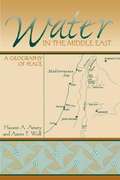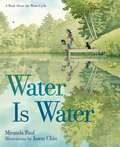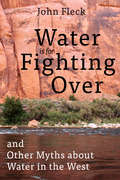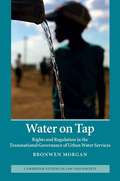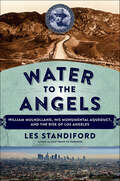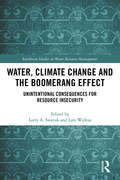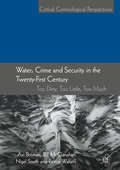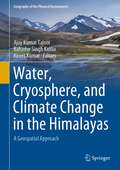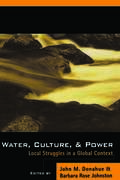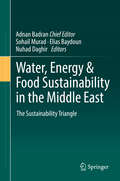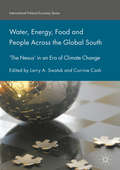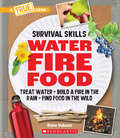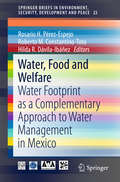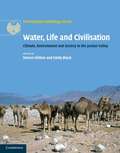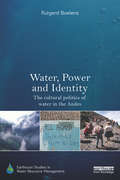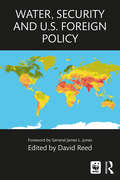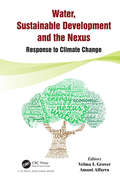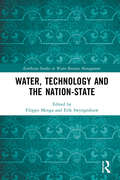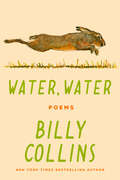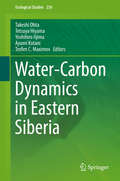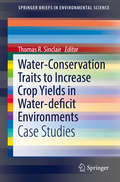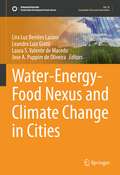- Table View
- List View
Water in the Middle East: A Geography of Peace
by Hussein A. Amery Aaron T. WolfFinding "streams in the desert" has never been more urgent for the peoples of the Middle East. Rapid population growth and a rising standard of living are driving water demand inexorably upward, while the natural supply has not increased since Biblical times. Ensuring a fair and adequate distribution of water in the region is vitally important for building a lasting peace among the nations of the Middle East.
Water is Water: A Book about the Water Cycle
by Jason Chin Miranda PaulThis spare, poetic picture book follows a group of kids as they move through all the different phases of the water cycle. From rain to fog to snow to mist, talented author Miranda Paul and the always remarkable Jason Chin (Redwoods, Coral Reefs, Island, Gravity) combine to create a beautiful and informative journey in this innovative nonfiction picture book that will leave you thirsty for more.
Water is for Fighting Over: and Other Myths about Water in the West
by John FleckWhen we think of water in the West, we think of conflict and crisis. In recent years, newspaper headlines have screamed,"Scarce water and the death of California farms," "The Dust Bowl returns," "A 'megadrought' will grip U.S. in thecoming decades." Yet similar stories have been appearing for decades and the taps continue to flow. John Fleck arguesthat the talk of impending doom is not only untrue, but dangerous. When people get scared, they fight for the last drop ofwater; but when they actually have less, they use less.Having covered environmental issues in the West for a quarter century, Fleck would be the last writer to discount theserious problems posed by a dwindling Colorado River. But in that time, Fleck has also seen people in the Colorado RiverBasin come together, conserve, and share the water that is available. Western communities, whether farmers and city-dwellers or US environmentalists and Mexican water managers, have a promising record of cooperation, a recordoften obscured by the crisis narrative.In this fresh take on western water, Fleck brings to light the true history of collaboration and examines the bondscurrently being forged to solve the Basin's most dire threats. Rather than perpetuate the myth "Whiskey's for drinkin', water's for fightin' over," Fleck urges readers to embrace a new, more optimistic narrative--a future where the Colorado continues to flow.
Water on Tap: Rights and Regulation in the Transnational Governance of Urban Water Services
by Bronwen MorganIn the 1990s and mid 2000s, turbulent political and social protests surrounded the issue of private sector involvement in providing urban water services in both the developed and developing world. Water on Tap explores examples of such conflicts in six national settings (France, Bolivia, Chile, Argentina, South Africa and New Zealand), focusing on a central question: how were rights and regulation mobilised to address the demands of redistribution and recognition? Two modes of governance emerged: managed liberalisation and participatory democracy, often in hybrid forms that complicated simple oppositions between public and private, commodity and human right. The case studies examine the effects of transnational and domestic regulatory frameworks shaping the provision of urban water services, bilateral investment treaties and the contributions of non-state actors such as transnational corporations, civil society organisations and social movement activists. The conceptual framework developed can be applied to a wide range of transnational governance contexts.
Water to the Angels: William Mulholland, His Monumental Aqueduct, and the Rise of Los Angeles
by Les StandifordThe author of Last Train to Paradise tells the story of the largest public water project ever created—William Mulholland’s Los Angeles aqueduct—a story of Gilded Age ambition, hubris, greed, and one determined man who's vision shaped the future and continues to impact us today.In 1907, Irish immigrant William Mulholland conceived and built one of the greatest civil engineering feats in history: the aqueduct that carried water 223 miles from the Sierra Nevada mountains to Los Angeles—allowing this small, resource-challenged desert city to grow into a modern global metropolis. Drawing on new research, Les Standiford vividly captures the larger-then-life engineer and the breathtaking scope of his six-year, $23 million project that would transform a region, a state, and a nation at the dawn of its greatest century.With energy and colorful detail, Water to the Angels brings to life the personalities, politics, and power—including bribery, deception, force, and bicoastal financial warfare—behind this dramatic event. At a time when the importance of water is being recognized as never before—considered by many experts to be the essential resource of the twenty-first century—Water to the Angels brings into focus the vigor of a fabled era, the might of a larger than life individual, and the scale of a priceless construction project, and sheds critical light on a past that offers insights for our future.Water to the Angels includes 8 pages of photographs.
Water, Civilisation and Power in Sudan
by Harry VerhoevenIn 1989, a secretive movement of Islamists allied itself to a military cabal to violently take power in Africa's biggest country. Sudan's revolutionary regime was built on four pillars - a new politics, economic liberalisation, an Islamic revival, and a U-turn in foreign relations - and mixed militant conservatism with social engineering: a vision of authoritarian modernisation. Water and agricultural policy have been central to this state-building project. Going beyond the conventional lenses of famine, "water wars" or the oil resource curse, Harry Verhoeven links environmental factors, development, and political power. Based on years of unique access to the Islamists, generals, and business elites at the core of the Al-Ingaz Revolution, Verhoeven tells the story of one of Africa's most ambitious state-building projects in the modern era - and how its gamble to instrumentalise water and agriculture to consolidate power is linked to twenty-first-century globalisation, Islamist ideology, and intensifying geopolitics of the Nile.
Water, Climate Change and the Boomerang Effect: Unintentional Consequences for Resource Insecurity (Earthscan Studies in Water Resource Management)
by Larry Swatuk Lars WirkusIn line with COP21 agreements, state-led climate change mitigation and adaptation actions are being undertaken to transition to carbon-neutral, green economies. However, the capacity of many countries for action is limited and may result in a ‘boomerang effect’, defined as the unintended negative consequences of such policies and programmes on local communities and their negative feedbacks on the state. To avoid this effect, there is a need to understand the policy drivers, decision-making processes, and impacts of such action, in order to determine the ways and means of minimizing negative effects and maximizing mutually beneficial policy outcomes. This book directly engages the policy debates surrounding water resources and climate actions through both theoretical and comparative case studies. It develops the ‘boomerang effect’ concept and sets it in relation to other conceptual tools for understanding the mixed outcomes of state-led climate change action, for example ‘backdraft’ effect and ‘maldevelopment’. It also presents case studies illustrative of the consequences of ill-considered state-led policy in the water sector from around the world. These include Africa, China, South Asia, South America, the Middle East, Turkey and Vietnam, and examples of groundwater, hydropower development and forest hydrology, where there are often transboundary consequences of a state's policies and actions. In this way, the book adds empirical and theoretical insights to a still developing debate regarding the appropriate ways and means of combating climate change without undermining state and social development.
Water, Crime and Security in the Twenty-First Century: Too Dirty, Too Little, Too Much (Critical Criminological Perspectives )
by Avi Brisman Nigel South Reece Walters Bill McClanahanWater, Crime and Security in the Twenty-First Century represents criminology’s first book-length contribution to the study of water and water-related crimes, harms and security. The chapters cover topics such as: water pollution, access to fresh water in the Global North and Global South, water and climate change, the commodification of water and privatization, water security and pacification, and activism and resistance surrounding issues of access and pollution. With examples ranging from Rio de Janeiro to Flint, Michigan to the Thames River, this original study offers a comprehensive criminological overview of the contemporary and historical relationship between water and crime. Coinciding with the International Decade for Action, “Water for Sustainable Development,” 2018–2028, this timely volume will be of particular relevance to students and scholars of green criminology, as well as those interested in critical geography, environmental anthropology, environmental sociology, political ecology, and the study of corporate crime and state crime.
Water, Cryosphere, and Climate Change in the Himalayas: A Geospatial Approach (Geography of the Physical Environment)
by Kireet Kumar Ajay Kumar Taloor Bahadur Singh KotliaThis edited book summarizes numerous research studies on remote sensing and GIS of natural resource management for the Himalaya region done by Indian Institutions and Universities over the last decade. It gives an overview of hydrometeorological studies on Himalayan water resources and addresses concerns in the development of water resources in this region, which is dealing with an increased pressure in population, industrialization and economic development. While the source of some of the major rivers of India are found in the Himalayas, the glaciers and water bodies in the region are continuously shrinking leading to a depletion of water and deterioration of water quality. This is affecting a population of up to 2.5 billion people. The ecosystems have been under threat due to deforestation, loss of biodiversity, expansion of agriculture and settlement, overexploitation of natural resources, habitat loss and fragmentation, poaching, mining, construction of roads and large dams, and unplanned tourism. Spaceborne remote sensing with its ability to provide synoptic and repetitive coverage has emerged as a powerful tool for assessment and monitoring of the Himalayan resources and phenomena. This work serves as a resource to students, researchers, scientists, professionals, and policy makers both in India and on a global level.
Water, Culture, and Power: Local Struggles In A Global Context
by John Donahue Barbara Rose JohnstonWater, Culture, and Power presents a series of case studies from around the world that examine the complex culture and power dimensions of water resources and water resource management.
Water, Energy & Food Sustainability in the Middle East
by Sohail Murad Elias Baydoun Nuhad DaghirThis book provides a survey of technologies available to tackle the problems associated with climate change in the energy, water and food security nexus with a special focus on the Middle East. It is divided into three main sections. The energy Section consists of six chapters, the water section of seven chapters and finally the food security section has six chapters. The individual chapters are authored by experts and provide discussions and in-depth views on the current status of each topic.
Water, Energy, Food and People Across the Global South
by Larry A. Swatuk Corrine CashThis collection critically engages the resource use nexus. Clearly, a nexus-approach to resource policy, planning and practice is essential if sustainable development goals are to be met. In particular, in an era of climate change, an integrated approach to water, energy and agriculture is imperative. Agriculture accounts for 70% of global water withdrawals, food production accounts for 30% of global energy use and a rising global population requires more of everything. As shown in this collection, scholars of resource development, governance and management are 'nexus sensitive', utilizing a sort of 'nexus sensibility' in their work as it focuses on the needs of people particularly, but not only, in the global South. Importantly, a nexus-approach presents academics and practitioners with a discursive space in which to shape policy through research, to deepen and improve understandings of the interconnections and impacts of particular types of resource use, and to critically reflect on actions taken in the name of the 'nexus'.
Water, Fire, Food: Treat Water, Build a Fire in the Rain, Find Food in the Wild (A True Book (Relaunch))
by Diane VukovicLearn basic survival skills and connect with nature!Knowing how to find safe drinking water, how to build a fire, and which foods are safe to eat — as well as which are not — are skills that every outdoor adventurer needs. Did you know that you can find edible plants right in your own backyard? Or that certain insects are super nutritious? Learn all this and more in Food, Water, and Fire—a book that gives kids the confidence they need to get outside and explore.ABOUT THE SERIES:Learning basic survival skills will give every kid the confidence — and the know-how — to handle emergencies and extreme situations. It also helps them feel comfortable and secure when they’re connecting with the outdoors while hiking, backpacking, or simply exploring the woods. The books in the Survival Skills series teach kids how to build a shelter from found materials, how to navigate (even without a compass), how to treat injuries in case of emergency, and so much more. These essential skills will give them the tools to take care of themselves in any situation.
Water, Food and Welfare
by Rosario Pérez-Espejo Roberto M. Constantino-Toto Hilda R. Dávila-IbáñezThis book addresses the following topics: the contemporary model for water management and alternative approaches; the socioeconomic framework, water policy and institutions; water use for food purposes, water-resources inventory and irrigation; manifestations of welfare loss and water prices; change in dietary patterns and water security; hydrological stress and pressures on water availability; groundwater management problems; vulnerability and climate change; water demand of major crops; gray water footprint and water pollution; gray water footprint and mining; virtual water and food trade; estimates of the water footprint of four key cereals, forage, livestock and bottled drinks. It is the result of a cooperation between 16 researchers from eleven Mexican academic institutions.
Water, Life and Civilisation
by Steven Mithen Emily BlackA unique interdisciplinary study of the relationships between climate, hydrology and human society from 20,000 years ago to the present day within the Jordan Valley. It describes how state-of-the-art models can simulate the past, present and future climates of the Near East, reviews and provides new evidence for environmental change from geological deposits, builds hydrological models for the River Jordan and associated wadis and explains how present day urban and rural communities manage their water supply. The volume provides a new approach and new methods that can be applied for exploring the relationships between climate, hydrology and human society in arid and semi-arid regions throughout the world. It is an invaluable reference for researchers and advanced students concerned with the impacts of climate change and hydrology on human society, especially in the Near East.
Water, Power and Identity: The Cultural Politics of Water in the Andes (Earthscan Studies in Water Resource Management)
by Rutgerd BoelensThis book addresses two major issues in natural resource management and political ecology: the complex conflicting relationship between communities managing water on the ground and national/global policy-making institutions and elites; and how grassroots defend against encroachment, question the self-evidence of State-/market-based water governance, and confront coercive and participatory boundary policing (‘normal’ vs. ‘abnormal’). The book examines grassroots building of multi-layered water-rights territories, and State, market and expert networks’ vigorous efforts to reshape these water societies in their own image – seizing resources and/or aligning users, identities and rights systems within dominant frameworks. Distributive and cultural politics entwine. It is shown that attempts to modernize and normalize users through universalized water culture, ‘rational water use’ and de-politicized interventions deepen water security problems rather than alleviating them. However, social struggles negotiate and enforce water rights. User collectives challenge imposed water rights and identities, constructing new ones to strategically acquire water control autonomy and re-moralize their waterscapes. The author shows that battles for material control include the right to culturally define and politically organize water rights and territories. Andean illustrations from Peru, Ecuador, Bolivia and Chile, from peasant-indigenous life stories to international policy-making, highlight open and subsurface hydro-social networks. They reveal how water justice struggles are political projects against indifference, and that engaging in re-distributive policies and defying ‘truth politics,’ extends context-particular water rights definitions and governance forms.
Water, Security and U.S. Foreign Policy
by David ReedThe prosperity and national security of the United States depend directly on the prosperity and stability of both partner and competing countries around the world. Today, U.S. interests are under rising pressure from water scarcity, extreme weather events and water-driven ecological change in key geographies of strategic interest to the U.S. Those water-driven stresses are undermining economic productivity, weakening governance systems and fraying social cohesion in scores of countries and, in the process, undermining the vitality of rural livelihoods, fostering local and ethnic conflicts, driving broad migratory movements and contributing to the growth of insurgencies and terrorist networks. While the U.S. intelligence community has steadily expanded natural resource concerns in their global threat analyses, our overseas development assistance remains locked into provision of water and hygienic services rather than responding to the full sweep of global water challenges including governance and policy failures, growing conflicts over water and the need for promoting sustainable transboundary water arrangements in partner countries. A fundamental departure from the past is urgently needed. Based on 18 case studies, Water, Security and U.S. Foreign Policy provides an analytical framework to help policy makers, scholars and researchers studying the intersection of U.S. foreign policy with the environment and sustainability issues, interpret the impacts of water-driven social disruptions on the stability of partner governments and U.S. interests abroad. The book also delivers specific recommendations to reorient U.S. development and diplomatic engagements that can forestall and prevent social disruptions and ensuing threats to U.S. prosperity and national security.
Water, State and the City
by Antonio A. R. IorisThe book investigates the complexity of the Latin American mega cities and the multiple commitments of the apparatus of the state with a focus on the failures of the public water sector. It offers an innovative interpretation of large-scale urbanization, one of the most challenging questions affecting Latin American governments and society.
Water, Sustainable Development and the Nexus: Response to Climate Change (Water)
by Velma I. Grover Amani AlfarraWater is intricately linked with food security, energy security, and sustainable development. As the world is moving towards sustainable development goals, it is critical to recognize the role of water in attaining these goals. The Water-Energy-Food Nexus draws attention to the complex and interrelated nature of global resource systems and forces us to think about how a decision in one sector impacts other interlinked sectors as well. This book looks at the three dimensions of sustainable development-environment, economics and society-and how water is linked with them and explores the nexus approach as a framework to look at the issues and identify solutions.
Water, Technology and the Nation-State (Earthscan Studies in Water Resource Management)
by Erik Swyngedouw Filippo MengaJust as space, territory and society can be socially and politically co-constructed, so can water, and thus the construction of hydraulic infrastructures can be mobilised by politicians to consolidate their grip on power while nurturing their own vision of what the nation is or should become. This book delves into the complex and often hidden connection between water, technological advancement and the nation-state, addressing two major questions. First, the arguments deployed consider how water as a resource can be ideologically constructed, imagined and framed to create and reinforce a national identity, and secondly, how the idea of a nation-state can and is materially co-constituted out of the material infrastructure through which water is harnessed and channelled. The book consists of 13 theoretical and empirical interdisciplinary chapters covering four continents. The case studies cover a diverse range of geographical areas and countries, including China, Cyprus, Egypt, Ethiopia, France, Nepal and Thailand, and together illustrate that the meaning and rationale behind water infrastructures goes well beyond the control and regulation of water resources, as it becomes central in the unfolding of power dynamics across time and space.
Water, Water: Poems
by Billy CollinsFrom the former Poet Laureate of the United States and New York Times bestselling author of Aimless Love comes a wondrous new collection of poems focused on the joys and mysteries of daily life.&“Among the best poems that [Billy] Collins has ever written.&”—Maureen Corrigan, NPR&“Witty, wry and tender when it hurts, Water, Water is a pleasure to read and easy to give.&”—The Washington Post&“Collins remains the most companionable of poetic companions.&”—The New York TimesIn this collection of sixty new poems, Billy Collins writes about the beauties and ironies of everyday experience. A poem is best, he feels, when it begins in clarity but ends with a whiff of mystery. In Water, Water, Collins combines his vigilant attention and respect for the peripheral to create moments of delight. Common and uncommon events are captured here with equal fascination, be it a cat leaning to drink from a swimming pool, a nurse calling a name in a waiting room, or an astronaut reciting Emily Dickinson from outer space. With his trademark lyrical informality, Collins asks us to slow down and glimpse the elevated in the ordinary, the odd in the familiar. It&’s no surprise that The New York Times and The Wall Street Journal both call Collins one of America&’s favorite poets.The Monet ConundrumIs every one of these poemsdifferent from the othershe asked himself,as the rain quieted down,or are they all the same poem,haystack after haystackat different times of day,different shadows and shades of hay?
Water-Associated Infectious Diseases
by Shailendra K. SaxenaThis book provides a comprehensive overview of the different water-associated infectious diseases and their linked pathogens with plausible strategies for their mitigation. Although, we are in the era of 21st century having most of the advanced technologies at hand, yet water-associated infectious diseases are the major contributors towards the worldwide morbidity and mortality. The book also focuses on the various implementation strategies of sustainable hygienic conditions, discusses the robust, and reliable policies and strategies on a global aspect to provide unprivileged people access to the basic sanitation, hygiene and water. In addition, the book discusses the possible indirect effect of global warming on the spread of infectious diseases through the distribution of associated vectors.
Water-Carbon Dynamics in Eastern Siberia (Ecological Studies #236)
by Tetsuya Hiyama Takeshi Ohta Yoshihiro Iijima Ayumi Kotani Trofim C. MaximovThis book discusses the water and carbon cycle system in the permafrost region of eastern Siberia, Providing vitalin sights into how climate change has affected the permafrost environment in recent decades. It analyzes the relationships between precipitation and evapotranspiration, gross primary production and runoff in the permafrost regions, which differ from those intropical and temperate forests. Eastern Siberia is located in the easternmost part of the Eurasian continent, and the land surface with underlying permafrost has developed over a period of seventy thousand years. The permafrost ecosystem has specific hydrological and meteorological characteristics in terms of the water and carbon dynamics, and the current global warming and resulting changes in the permafrost environment are serious issues in the high-latitude regions. The book is a valuable resource for students, researchers and professionals interested in forest meteorology and hydrology, forest ecology, and boreal vegetation, as well as the impact of climate change and water-carbon cycles in permafrost and non-permafrost regions.
Water-Conservation Traits to Increase Crop Yields in Water-deficit Environments
by Thomas R. SinclairThis volume explores specific approaches that have shown to result in crop yield increases. Research on the physiological understanding of these methods has led to the development of practical applications of plant breeding approaches to genetically improve crops to achieve higher yields. Authoritative entries from crop scientists shed new light on two water-conservation traits: one that is based on an initiation of the decrease in transpiration earlier in the soil drying cycle, and the second that is based on a sensitivity of transpiration rate under high atmospheric vapor pressure deficit that results in partial stomatal closure. Both these approaches involve partial stomatal closure under well-defined situations to decrease the rate of soil water loss. Readers will be able to analyze the circumstances under which a benefit is achieved as a result of the water-limitation trait; and key discussion points in the case studies presented will help answer questions such as what species, which environments, how often will yield be benefited for various crop species? Contributions also review the genetic variation for these two traits within each crop species and the physiological basis for the expression of these traits.
Water-Energy-Food Nexus and Climate Change in Cities (Sustainable Development Goals Series)
by Jose A. Puppim de Oliveira Leandro Luiz Giatti Lira Luz Benites Lazaro Laura S. Valente de MacedoThis book aims to contribute to the transdisciplinary study of the water-energy-food (WEF) nexus in cities and to help policy makers adopt a more integrated approach to natural resources management in urban environments to face the challenges and threats of climate change. This approach is based on a multidimensional scientific framework that seeks to understand the complex and non-linear interrelationships and interdependencies between water-energy-food under climate change and to generate solutions to reduce trade-offs among development goals and generate co-benefits that help encourage sustainable development and contribute to the achievement of SDGs, mainly SDG 11 (make cities and human settlements inclusive, safe, resilient and sustainable) and SDG 13 (take urgent action to combat climate change and its impacts).Governing the WEF nexus in cities is one of the greatest resource challenges of our time, as cities consume large amounts of WEF, but one that can also generate relevant alternatives with which to tackle climate change. To help fostering these alternatives, this book analyzes the governance, institutional and political economy factors that determine the effectiveness of the nexus approach and reviews the potential, the benefits and the policy implications of the adoption of the WEF nexus approach at the urban level. Through a series of hands-on cases, chapters in this book present the opportunities of the WEF nexus approach to achieve innovation and transformative change and discuss concrete areas of synergy and policy initiative to raise urban resilience. Water-Energy-Food Nexus and Climate Change in Cities will serve both as a guide for policy makers as well as a useful resource for students and researchers in fields such as urban studies, public health, environmental sciences, energy studies and public policy interested in learning how cities can represent possibilities to navigate and manage sustainability from local to global.
